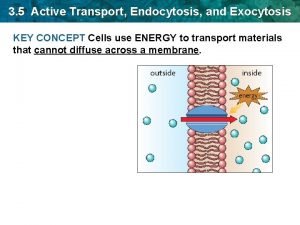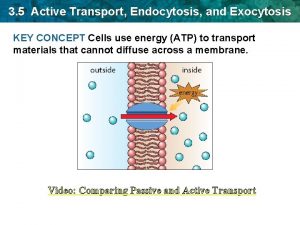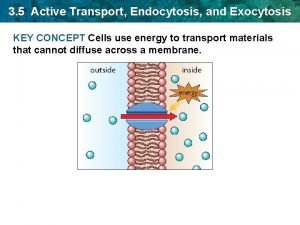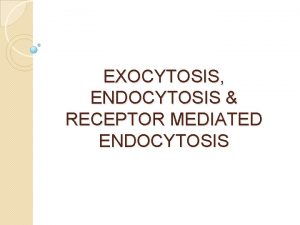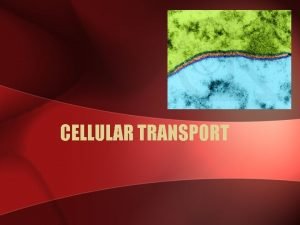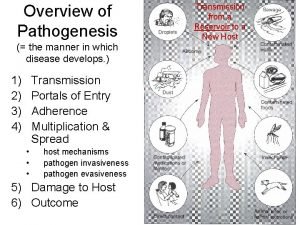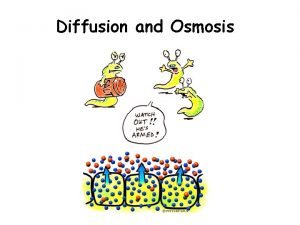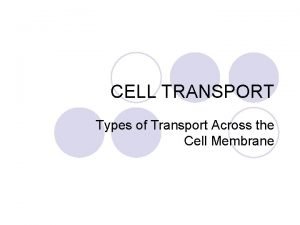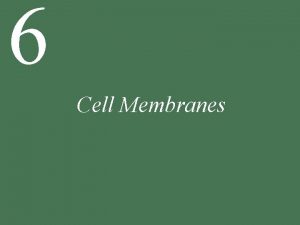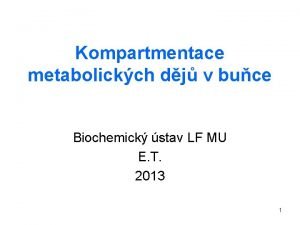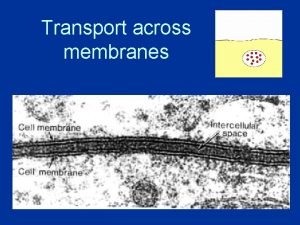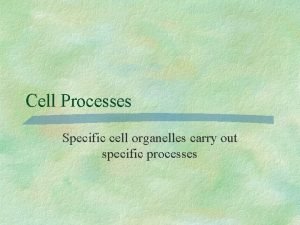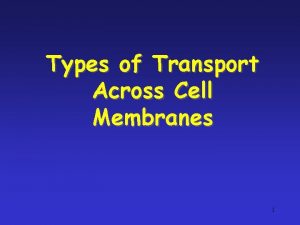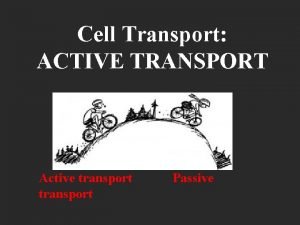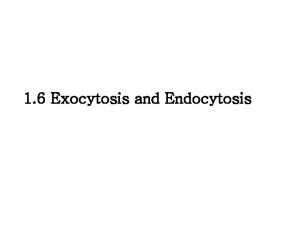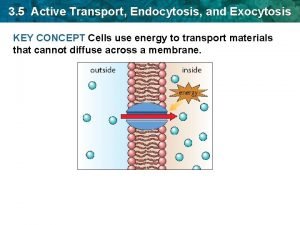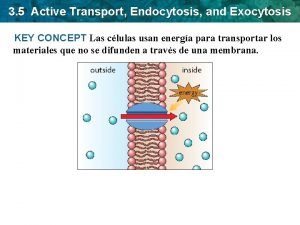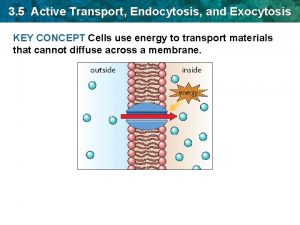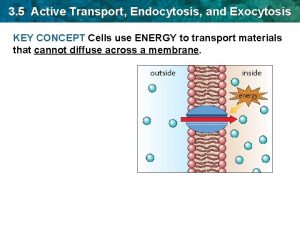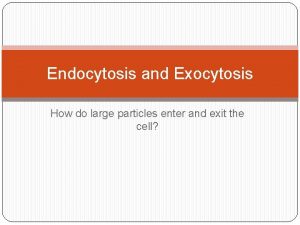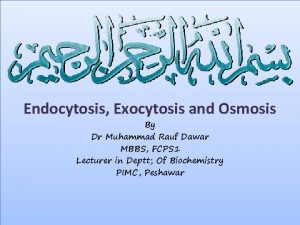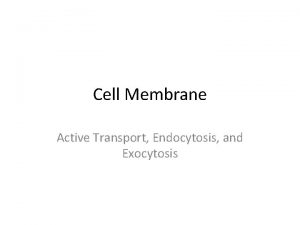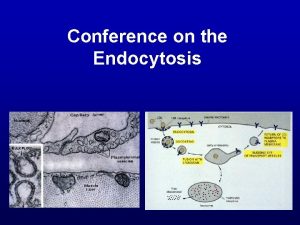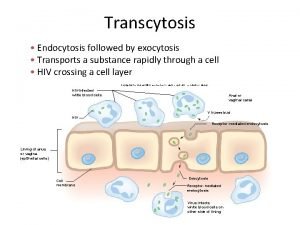1 6 Exocytosis and Endocytosis 1 Exocytosis from




















- Slides: 20

1. 6 Exocytosis and Endocytosis

1. Exocytosis: - from TGN to PM, - proteins, lipids, polysaccharides, glycoproteins, proteoglycans


Endocytosis: - retrives excess membrane for recycling through the formation of PM membrane infolding. - turn over PM and cell wall molecules - remove activated receptors from the cell surface - In animals, plays major role in the uptake of nutrients but little evidence suggests such a role in plants

1) In plants , turgor pressure affects membrane events associated with exocytosis and membrane recycling.

Fig 1 -29. Cross section images of secretory vesicles.

2) Turgor pressure also affects endocytosis and membrane recycling


3) The membrane compartments associated with endocytosis can be identified by following the uptake of tracer molecules. (A) Clathrin-coated vesicles budding from a PM (B) higher magnification TEM of clathrin-coated vesicles.

The endocytic pathway Plasma membrane/extracellular space Clathrin-coated pits and vesicles Non-coated vesicles Partially coated reticulum (likely extention of the TGN) Multivesicular bodies, organelles (not to be destined for degradation) Vacuoles

Multivesicular body in the cytoplasm of a tobacco cell

1. 7. Vacuoles - Fluid filled compartments encompassed by a membrane, called the tonoplast Conspicuous organelles of most plant cells Numerous small vacuoles in apical meristem cells combine into one or a few larger vacuoles as the cell matures and expands Mesophyll leaf cell Root meristem cell

View of spongy mesophyll cells in a bean leaf

Vacuoles store a large variety of molecules : inorganic ions, organic acids, sugars, enzymes, store proteins and many types of secondary metabolites. - solutes -> water -> turgor pressure -> cell enlargement Many hydrolytic enzymes found in vacuoles, suggesting a role in turnover of cellular constituents (like lysosomes in animal cells) Many hydrolytic enzymes results in HR-like cell death in response to pathogen

1) Plants use vacuoles to produce large cells cheaply - To maintain the turgor pressure of, solutes must be actively transported into the growing vacuole. - Electrochemical gradient is produced by two proton pumps (V-type H+-ATPase and H+-pyrophosphatase (H+-PPase) - The movements of water across the tonoplast is mediated by aquarin channels

2) Plant vacuoles are multifunctional compartments a. Storage: inorganic ions, organic acids, sugars, enzymes, store proteins and many types of secondary metabolites b. Digestion: acid hydrolases (protease, nuclease, glycosidase, and lipases) are found in. recycling (turnover and retrieval of nutrients) c. p. H and ionic homeostasis: reseiviers of protons and ions (calcium) regulates cytosolic p. H, the activity of enzymes, the assembly of cytoskeletal structures and membrane fusion d. Defense against microbial pathogens and hebivores: - phenolic compounds, alkaloids, cyanogenic glycosides and protease inhibitor to insect and herbivores - cell degrading enzymes; chitinase and glucanase, defense molecules to fungi and bacteria - latexes, to insect and fungi herbivores

e. Sequstration of toxic compounds: heavy metals toxic metabolites (oxalate) f. Pigmentation: antocyanin pigments – attract pollinator and seed dispersers - screen out UV and visible light preventing photooxidative damage

3) Many plant cells contains two different vacuole systems a. Neutral protein vacuoles (V 1) b. Acidic, lytic vacuoles (V 2)

4) Vacuoles may be the only membrane compartments that can be created de novo 1) provacuoles arise from ER domain in which H+-ATPases, a-TIP and stoage proteins accumulate After their separation from ER, provacuoles inflate they become full-fledged vacuoles 2) the central vacuole appears to arise from smooth ER tubes these tubes assemble in to a cage-like structure cleared of organells then autophagocytosed into the forming vacuole or displaced as the vacuole tube fuse and inflate.

1. 8 The nucleus - Contains most of the cell’s genetic information - Serves as the center of regulatory activity
 Active transport endocytosis and exocytosis
Active transport endocytosis and exocytosis Section 5 active transport endocytosis and exocytosis
Section 5 active transport endocytosis and exocytosis Exocytosis passive or active
Exocytosis passive or active Pinocytosis vs phagocytosis
Pinocytosis vs phagocytosis Bulk transport
Bulk transport Process of endocytosis
Process of endocytosis Endocytosis analogy
Endocytosis analogy Receptor mediated endocytosis
Receptor mediated endocytosis Na+ k+ pump
Na+ k+ pump Diffusion and osmosis
Diffusion and osmosis Types of cellular transport
Types of cellular transport Receptor - mediated endocytosis
Receptor - mediated endocytosis Kompartmentace
Kompartmentace What is cell drinking
What is cell drinking Section 7-1 life is cellular answer key
Section 7-1 life is cellular answer key 3 types of active transport
3 types of active transport Selectively permeable definition biology
Selectively permeable definition biology Integral and peripheral proteins
Integral and peripheral proteins Exocytosis
Exocytosis Active transport low to high
Active transport low to high Exocytosis
Exocytosis
